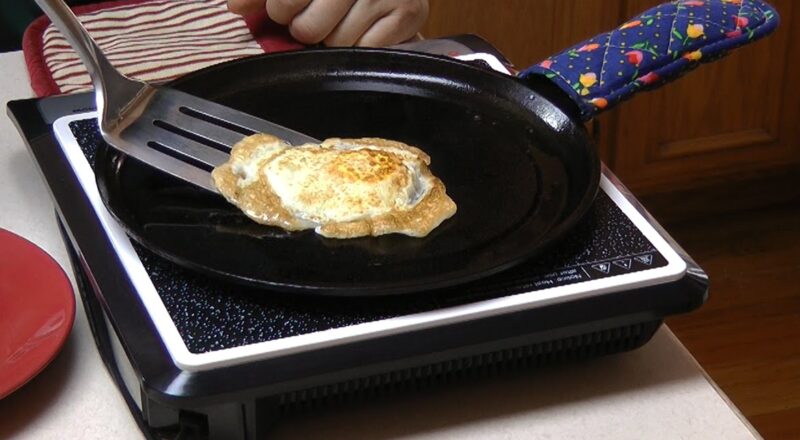The energy usage of cast iron on induction cooktops is a topic of growing interest among kitchen enthusiasts and professionals alike. As more people look to incorporate energy-efficient practices into their cooking routines, understanding how cast iron performs on induction stoves becomes crucial. In this article, we will delve into the various aspects of using cast iron on induction cooktops, including its efficiency, benefits, and any potential drawbacks.

Understanding Induction Cooking
Induction cooking uses electromagnetic fields to heat cookware directly. This method is known for its speed and efficiency, making it an attractive option for modern kitchens. Unlike traditional gas or electric stoves, induction cooktops do not transfer heat through a flame or electric coil. Instead, the heat is generated directly in the pot or pan. This technology requires cookware made of ferrous metal, which makes cast iron a perfect candidate.
Why Choose Cast Iron?
Cast iron is a popular choice for many cooks due to its durability and even heat distribution. Its a versatile material that can be used for a variety of cooking techniques, from frying to baking. Moreover, cast iron retains heat well, which can help in maintaining a consistent cooking temperature.
Energy Efficiency of Cast Iron on Induction
One of the main advantages of using cast iron on induction cooktops is its energy efficiency. Induction stoves are known for their ability to heat pans quickly and evenly, reducing cooking times and saving energy. The combination of induction technology and cast iron’s heat retention capabilities means less energy is required to maintain the desired cooking temperature. [Learn more about induction cooking]
Heat Distribution and Cold Spots
While cast iron is excellent at retaining heat, it can sometimes develop cold spots, especially if the induction cooktop’s magnetic field does not fully cover the bottom of the pan. This can lead to uneven cooking. For tips on how to deal with this, you can read about cold spots in cast iron.
Matching Pan Size with Induction Ring
Another factor that affects energy efficiency is how well the pan size matches the induction ring. If the pan is too small or too large, it may not heat evenly, which can waste energy and affect cooking performance. For guidance on the best practices, you can check out these insights on matching pan size.
Benefits of Using Cast Iron on Induction
The benefits of using cast iron on induction cooktops are numerous. Induction cooking is generally safer, as the cooktop remains cool to the touch. Additionally, the precise temperature control that induction offers can enhance cooking results. Moreover, cast iron’s durability means it can withstand the high temperatures and quick heating capabilities of induction cooking without warping.
Reducing Energy Consumption
Using cast iron on induction can help reduce your overall energy consumption in the kitchen. Because induction heats up quickly and maintains temperature efficiently, it reduces the time and energy needed to cook meals. This efficiency not only saves energy but also cuts down on cooking time, making it a win-win scenario for busy kitchens.
Environmental Impact
Cooking with energy-efficient methods such as induction can also have a positive environmental impact. By reducing energy usage, you contribute to lowering your carbon footprint. This makes induction cooking with cast iron an environmentally friendly choice.
Potential Drawbacks
Despite the advantages, there are some potential drawbacks to using cast iron on induction cooktops. Cast iron is heavy, which can make it cumbersome to handle, especially when full. It is also prone to rust if not properly maintained. Additionally, if the pan is not perfectly flat, it may not make full contact with the cooktop, impacting efficiency.
Dealing with Uneven Browning
Sometimes, cooks may experience uneven browning when using cast iron on induction. This can be due to the pan not being completely flat or other factors. For more information on this, you can explore solutions to uneven browning.
Handling Smoky Pans
Another issue that might arise is the pan becoming smoky. This can occur if the pan is not seasoned correctly or if food residues are left in the pan. For tips on handling this, you can visit cast iron becoming smoky.
Conclusion
In conclusion, the energy usage of cast iron on induction cooktops is efficient and effective, offering numerous benefits for kitchen professionals and enthusiasts. By understanding how to properly use and maintain your cast iron cookware, you can enhance your cooking experience while being mindful of energy consumption. Induction cooking with cast iron not only provides precise temperature control but also contributes to a more sustainable cooking practice. As with any cooking method, being aware of potential challenges and knowing how to address them can help you make the most of your kitchen adventures.

FAQ
Is cast iron suitable for all induction cooktops?
Yes, as long as the cast iron cookware has a flat base and is made of ferrous metal, it is suitable for use on induction cooktops.
How can I prevent my cast iron from rusting?
To prevent rust, ensure your cast iron cookware is thoroughly dried after washing and periodically season it with a thin layer of oil.
What should I do if my cast iron pan develops cold spots?
If you encounter cold spots, try repositioning the pan on the cooktop or consider using a pan with a thicker base to enhance even heat distribution.
This article contains affiliate links. We may earn a commission at no extra cost to you.

